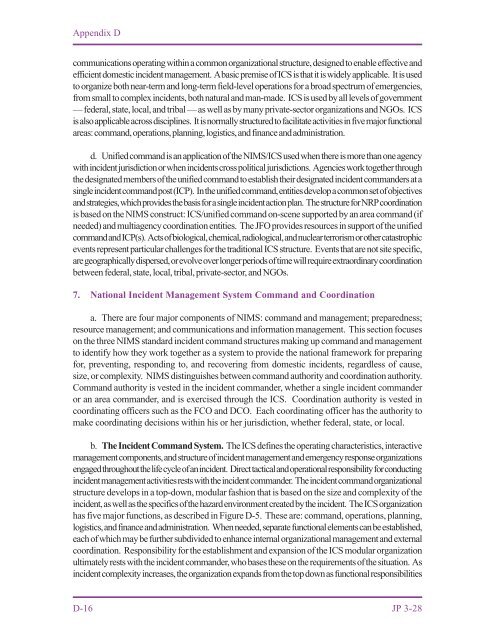JP 3-28, Civil Support - Federation of American Scientists
JP 3-28, Civil Support - Federation of American Scientists
JP 3-28, Civil Support - Federation of American Scientists
You also want an ePaper? Increase the reach of your titles
YUMPU automatically turns print PDFs into web optimized ePapers that Google loves.
Appendix D<br />
communications operating within a common organizational structure, designed to enable effective and<br />
efficient domestic incident management. A basic premise <strong>of</strong> ICS is that it is widely applicable. It is used<br />
to organize both near-term and long-term field-level operations for a broad spectrum <strong>of</strong> emergencies,<br />
from small to complex incidents, both natural and man-made. ICS is used by all levels <strong>of</strong> government<br />
— federal, state, local, and tribal — as well as by many private-sector organizations and NGOs. ICS<br />
is also applicable across disciplines. It is normally structured to facilitate activities in five major functional<br />
areas: command, operations, planning, logistics, and finance and administration.<br />
d. Unified command is an application <strong>of</strong> the NIMS/ICS used when there is more than one agency<br />
with incident jurisdiction or when incidents cross political jurisdictions. Agencies work together through<br />
the designated members <strong>of</strong> the unified command to establish their designated incident commanders at a<br />
single incident command post (ICP). In the unified command, entities develop a common set <strong>of</strong> objectives<br />
and strategies, which provides the basis for a single incident action plan. The structure for NRP coordination<br />
is based on the NIMS construct: ICS/unified command on-scene supported by an area command (if<br />
needed) and multiagency coordination entities. The JFO provides resources in support <strong>of</strong> the unified<br />
command and ICP(s). Acts <strong>of</strong> biological, chemical, radiological, and nuclear terrorism or other catastrophic<br />
events represent particular challenges for the traditional ICS structure. Events that are not site specific,<br />
are geographically dispersed, or evolve over longer periods <strong>of</strong> time will require extraordinary coordination<br />
between federal, state, local, tribal, private-sector, and NGOs.<br />
7. National Incident Management System Command and Coordination<br />
a. There are four major components <strong>of</strong> NIMS: command and management; preparedness;<br />
resource management; and communications and information management. This section focuses<br />
on the three NIMS standard incident command structures making up command and management<br />
to identify how they work together as a system to provide the national framework for preparing<br />
for, preventing, responding to, and recovering from domestic incidents, regardless <strong>of</strong> cause,<br />
size, or complexity. NIMS distinguishes between command authority and coordination authority.<br />
Command authority is vested in the incident commander, whether a single incident commander<br />
or an area commander, and is exercised through the ICS. Coordination authority is vested in<br />
coordinating <strong>of</strong>ficers such as the FCO and DCO. Each coordinating <strong>of</strong>ficer has the authority to<br />
make coordinating decisions within his or her jurisdiction, whether federal, state, or local.<br />
b. The Incident Command System. The ICS defines the operating characteristics, interactive<br />
management components, and structure <strong>of</strong> incident management and emergency response organizations<br />
engaged throughout the life cycle <strong>of</strong> an incident. Direct tactical and operational responsibility for conducting<br />
incident management activities rests with the incident commander. The incident command organizational<br />
structure develops in a top-down, modular fashion that is based on the size and complexity <strong>of</strong> the<br />
incident, as well as the specifics <strong>of</strong> the hazard environment created by the incident. The ICS organization<br />
has five major functions, as described in Figure D-5. These are: command, operations, planning,<br />
logistics, and finance and administration. When needed, separate functional elements can be established,<br />
each <strong>of</strong> which may be further subdivided to enhance internal organizational management and external<br />
coordination. Responsibility for the establishment and expansion <strong>of</strong> the ICS modular organization<br />
ultimately rests with the incident commander, who bases these on the requirements <strong>of</strong> the situation. As<br />
incident complexity increases, the organization expands from the top down as functional responsibilities<br />
D-16<br />
<strong>JP</strong> 3-<strong>28</strong>

















